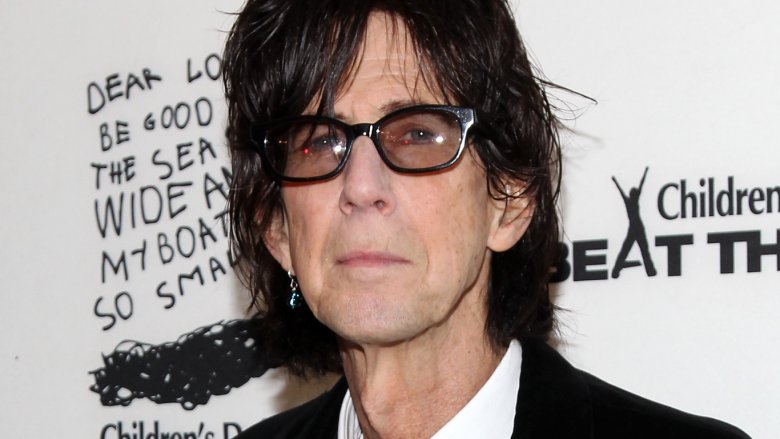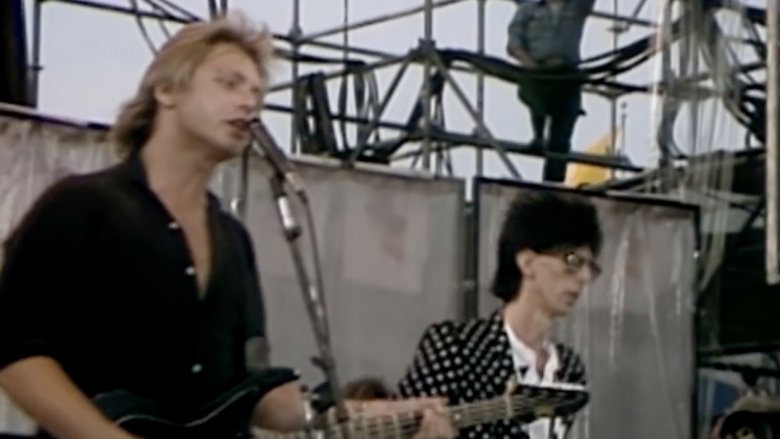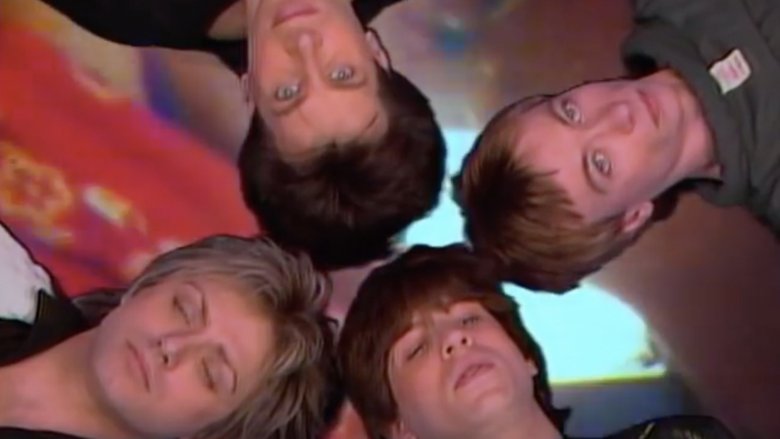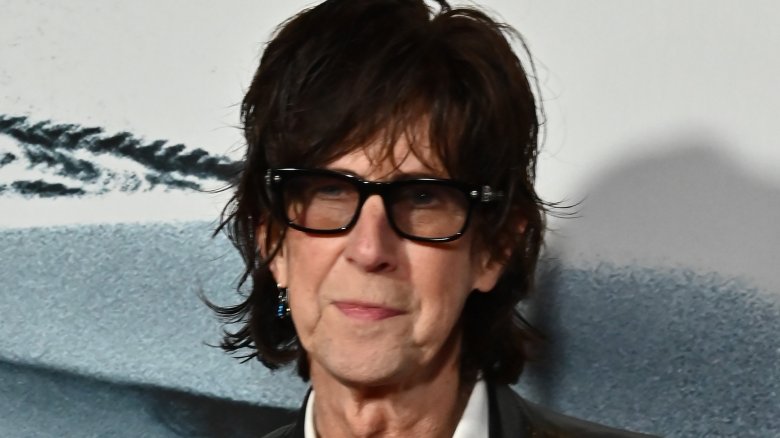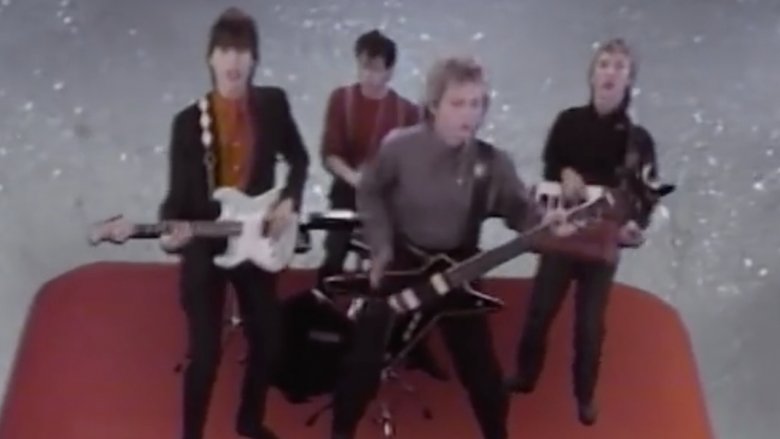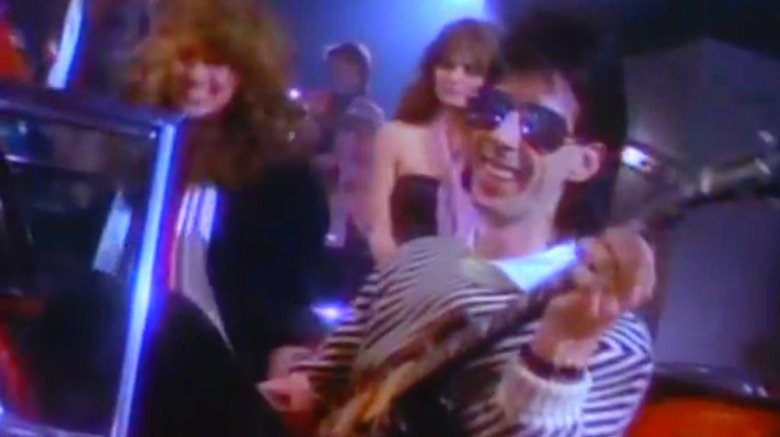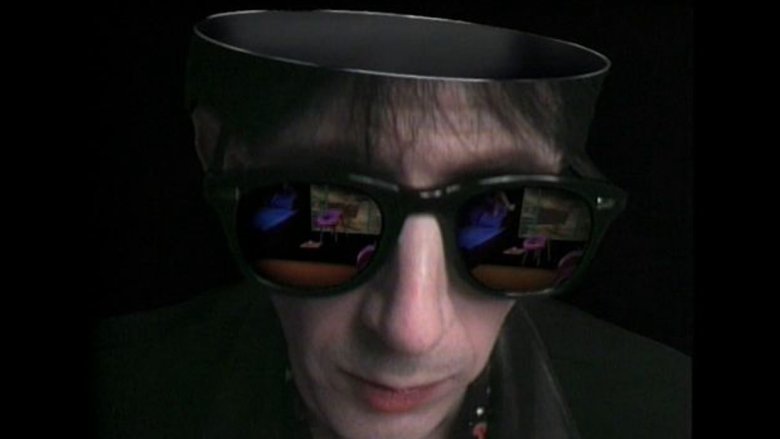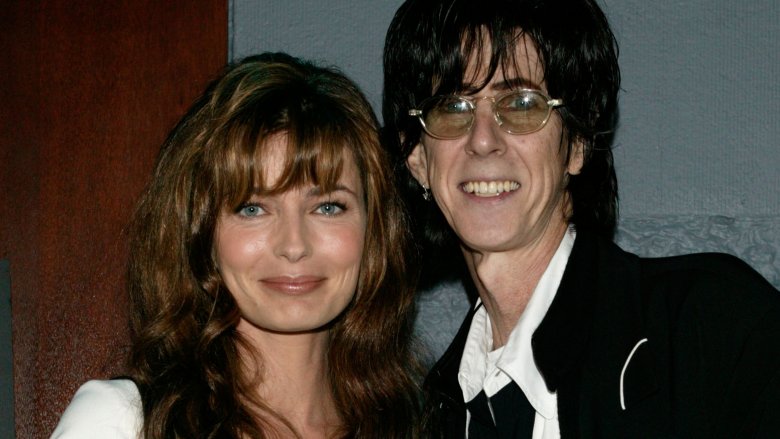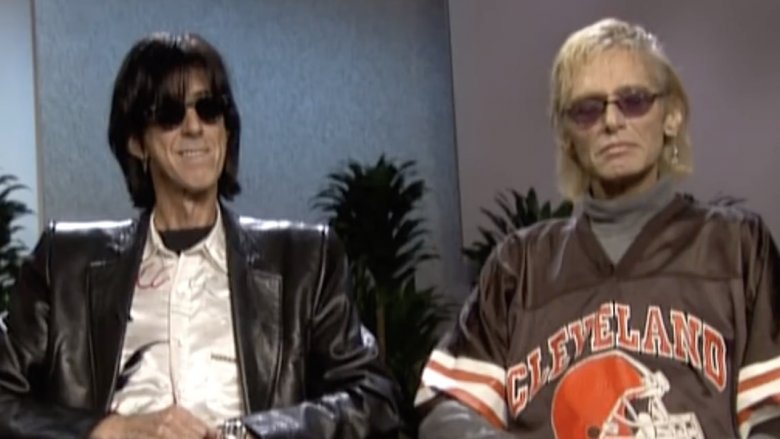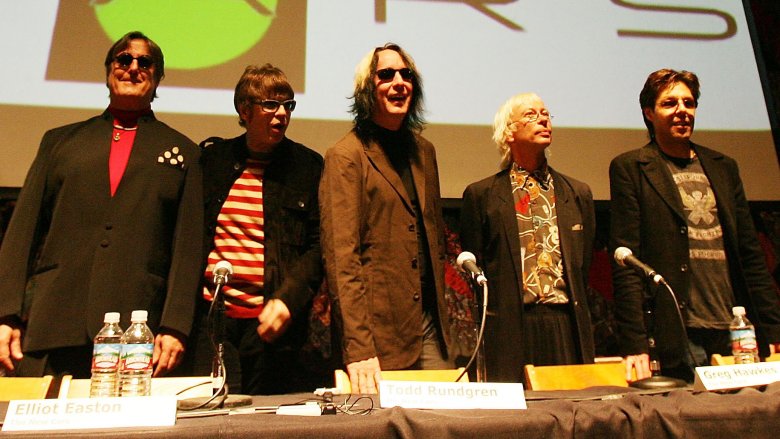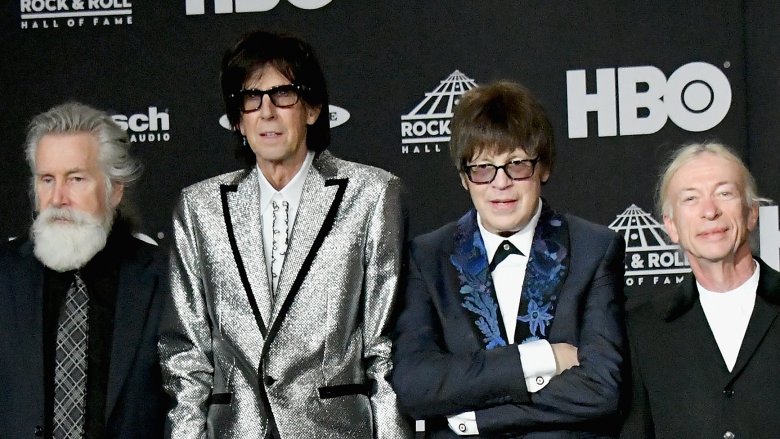The Untold Truth Of The Cars
Ric Ocasek and Benjamin Orr formed the Cars in 1976, having played together in a number of failed bands. Once they found guitarist Elliot Easton, keyboardist Greg Hawkes, and drummer David Robinson, the band that would one day perform "Magic" had found just what they needed. The Cars helped create one of the definitive sounds of the late 1970s and evolved into arguably the most '80s band of the '80s. They started out New Wave, mixing pop craftsmanship with hard rock energy, then adding in synthesizers and smooth production. They also utilized the music video in a big way, producing entertaining and well-made clips for their many hit songs. And the Cars had a lot of hits, including "Just What I Needed," "My Best Friend's Girl," "Hello Again," "Drive," and "Tonight She Comes."
The Cars broke up at the end of the '80s, only to reunite in the 2010s (without the deceased Orr) and play together one more time at their Rock and Roll Hall of Fame induction. In 2019, the death of Ocasek meant the Cars are now a part of music history. Here's a look under the hood of the Cars.
When Ric Ocasek met Benjamin Orr
The Cars, arguably the definitive band of the 1980s, came together as the result of a very 1960s phenomenon: a local variety show. Ric Ocasek relocated with his family from Maryland to Cleveland, Ohio in the 1960s, and one night in 1965 he caught Benjamin Orr's band the Grasshoppers performing on the black-and-white musical showcase The Big 5 Show. The two struck up a friendship and three years later, when both had moved to Columbus, Ohio, they formed their first (of several) bands together, ID Nirvana. After a couple of other moves from Ann Arbor, Michigan, to Boston, they started another group, a folk ensemble called Milkwood.
Ocasek and Orr seemed to be on their way — Milkwood signed with Paramount Records and released an album in 1972, but it sold poorly and the band fell apart. Undeterred, the duo put together another group, Richard and the Rabbits, recruiting musician Greg Hawkes to play the keyboards, having liked the saxophone work he contributed to Milkwood's one and only record. Hawkes soon left to play in comedian Martin Mull's stage act and the country-rock band Orphan, leaving Ocasek and Orr as a coffeehouse duo called, well, Ocasek and Orr. Otherwise, the two paid the bills with day jobs in clothing stores while recording demos in a Boston studio which they paid for in trade, doing carpentry for the owner.
The Cars had that Swing, but it didn't mean a thing
In early 1976, Ric Ocasek and Benjamin Orr formed yet another band, a more straightforward pop-rock combo called Cap'n Swing. The musicians inched closer to the Cars and the Cars sound, particularly when they added recent Berklee College of Music graduate and Boston guitarist Elliot Easton to the mix. Cap'n Swing recorded some demos and played the Newport Street Music Fair, a showcase sponsored by popular local station WBCN, and caught the attention of afternoon disc jockey Maxanne Sartori — who had previously helped launch the career of Aerosmith — who helped solidify the group's lineup. After seeing the band play a gig in New York, "I suggested that Ric shift Ben Orr from singing lead vocals to playing bass and sharing lead vocals with Ric," Sartori told the Wall Street Journal. She also suggested to Ocasek that he hire a new drummer: David Robinson, formerly of the cult favorite Modern Lovers, because he "had more of a pop feel."
Sartori recommended Robinson because Cap'n Swing's first attempts to go national had failed. On the strength of their popularity in Boston, Cap'n Swing got booked for a series of showcases for management companies, and struck out. That, plus the addition of Robinson, and a reunion with Greg Hawkes, triggered a reworking of Cap'n Swing into the Cars.
The Cars: A name so simple it just might work
Tweaking its sound and lineup weren't the only things Ric Ocasek, Benjamin Orr, and other members of Cap'n Swing had to address as they went forward. There was also the matter of the band's name, which, come on, is a terrible name, combining as it did the weirdly truncated first part of the name of a popular breakfast cereal with the name of a musical genre in which the band did not participate.
"Shortly after I joined," drummer David Robinson told the Wall Street Journal, "Ric wanted to change the band's name," because "Cap'n Swing sounded like the name of a bar band." So, the musicians sat around and devised a list of possible band names. It was Robinson who mentioned the Cars, the entry that everybody seemed to like. "It was easy to remember and it wasn't pegged to a specific decade or sound," Robinson said. "The name was meaningless and conjured up nothing, which was perfect." Furthermore, Ocasek liked the Cars because it fell at the beginning of the alphabet, which would earn the band good placement in record stores, and also that it was easy to spell.
When the Cars broke, they broke fast
The rise and fall of Cap'n Swing occurred entirely within the calendar year of 1976, an annum that closed out with Ric Ocasek and company playing its first gig as the Cars in December. Just two months later, the band recorded a demo tape of its new songs, including early takes on what would become signature songs, "My Best Friend's Girl" and "Just What I Needed." The musicians' old friend, Maxanne Sartori, enthusiastically played those two tracks on her afternoon radio show on Boston's WBCN, prompting a huge (and positive) listener response. And because WBCN was a commercial radio station, Saroti kept logs of the songs she played, which get send to music industry trade publications.
Record companies took notice of this unsigned, unheard of band getting tons of airplay in a major media market, and the band fielded offers from many labels. "We signed with Elekra," Ric Ocasek told the Wall Street Journal. "Every artist I loved was on Elektra." By the time 1977 was over, the Cars had signed a record deal and hit the road to build both hype and a fanbase. In February 1978, the group recorded its self-titled debut album in a mere 12 days.
The Cars shake it down
The Cars recorded plenty of sharp, to the point, tightly crafted pop-rock jams. But just because they're short and sweet doesn't mean they don't take a long time to make. According to Cars drummer David Robinson, the band's 1981 hit "Shake It Up" stewed for years before the group finally decided to record it. "It never sounded good," he said in Frozen Fire: The Story of the Cars. "We recorded it a couple of times in the studio and dumped it, and we were going to try it one more time, and I was fighting everybody." Robinson just really did not want to shake it up with "Shake It Up," but relented when the band decided to give it fresh ears and a total overhaul. "So we thought, let's start all over again, like we've never even heard it — completely change every part — and we did."
Still, not every Car was happy. "I've probably written some crap lyrics," Ric Ocasek told Vanity Fair. "I'm not proud of the lyrics to 'Shake It Up.'" He apparently didn't dig the lines he'd written for this early '60s throwback tune, such as "Do the move with the quirky jerk" and "make the night cats stop and stare."
You might think the Cars liked making videos
"You Might Think" is arguably the Cars' most memorable song, and that's probably because of its unforgettable music video. The Cars' rise to the top coincided with the early days of MTV, and the band was among the handful of acts that embraced the new medium. Elektra Records executive Robin Sloane asked music video director Jeff Stein to make a clip for the Cars' Heartbeat City bouncy, synth-driven single "You Might Think." Stein was inspired by a National Enquirer ad campaign that "had animated cutouts and photographs of celebrities, big heads on bodies that moved a little," he said in I Want My MTV. He heard "You Might Think" and figured he "could make the first cartoon with real people."
He had a tough time selling the band on that idea. "I met the Cars and told them, 'The band's in the medicine chest, and then on a bar of soap, and Ric's a fly,' and one of them said, 'Why don't we all just play on a turd in the toilet bowl?' That was the prevailing attitude." According to Sloane, Ric Ocasek "hated" the video because "he thought it made fun of the way he looked." But it all paid off. The video became the first one placed in the Museum of Modern Art's permanent collection, and at the first MTV Video Music Awards in 1984 "You Might Think" won Video of the Year, somehow defeating Michael Jackson's iconic "Thriller."
Drive drove the Cars home
Fresh off his Academy Award-winning role in Ordinary People, actor Timothy Hutton wanted to get into directing, and in 1984 the Cars' manager played him the group's album Heartbeat City. Hutton was particularly taken with "Drive," a slick, romantic soft rock ballad that represented a departure for the power pop/New Wave band. Ric Ocasek allowed Hutton to direct a video for the song, and one of the first things he did was call a casting director. "I needed an attractive, exotic woman who has something fierce about her," Hutton said in I Want My MTV. He hired model Paulina Porizkova, among the last women he met with, and set her and Ocasek up in a hotel room to rehearse the plot of the video, asking the two "to imagine they'd had a fight that was escalating." They rehearsed with Hutton for an entire day, and when it was all over, Porizkova and Ocasek wanted to keep going. Sparks had obviously flown, although Porizkova later told Entertainment Weekly that she'd seen Ocasek on MTV before and it was "love before first sight." Also, Ocasek was already married at the time, to his second wife. In 1989, the model and rock star got married, and they stayed together for nearly 30 years.
The complicated friendship of Ric Ocasek and Benjamin Orr
The Cars were a band, but to the public, the Cars and Ric Ocasek were one and the same, probably because of his striking look or because he sang most of the bands' songs. But he wasn't the only Car who made some noise — Benjamin Orr took lead vocals on seminal songs like "Just What I Needed," "Drive," and "Moving in Stereo." Casual listeners may not have realized the band had two singers because their voices are tough to distinguish from each other. "I think our voices are similar because we spent so many years together even before the Cars," Ocasek told Vanity Fair. "Every band I've ever been in had both of us." Ocasek later told Rolling Stone that while he and Orr were "the best of friends forever," by the end of the Cars' last tour in the late '80s, Orr had taken to traveling on his own bus, apart from the other band members and rarely exchanging words with Ocasek. "He was drinking a little much," Ocasek said, adding that there was some tension with Orr when the latter asked if he could write song Cars songs with his girlfriend. Ocasek rejected that idea outright.
The former besties and musical partners grew estranged after the Cars split up in 1988. Fortunately, they worked out their differences while taping material for a Cars DVD in the late '90s. Orr died of pancreatic cancer in 2000, and Ocasek paid tribute with the song "Silver."
New Cars for everyone
The members of the Cars who were not the two frontmen — Greg Hawkes, Elliot Easton, and David Robinson — thought that nearly two decades of a break was all the time they needed away from the band. Sometime in the mid-2000s, a manager representing those three musicians approached Ric Ocasek in his office at Elektra Records, where he was working in talent scouting and development. This manager proposed a Cars reunion on behalf of his clients, but Ocasek gave him a hard no. "The sh*t hit the fan," Ocasek later said to Rolling Stone. "Lawyers got involved. It must have cost a ton of money in legal fees that I wasted, the Cars wasted, for f*cking no reason." So while the Cars didn't reform at that time, a version of the band did. Easton and Hawkes (but not Robinson, who dropped out of the project early on) hit the road in 2006 and 2007 as the New Cars. This reasonable facsimile of a classic rock group replaced the tough-if-not-impossible-to-replace Ocasek, Robinson, and Benjamin Orr with some notable, talented guys, including rock legend and producer Todd Rundgren and the Tubes drummer Prairie Prince. At the band's kickoff show at the House of Blues, the New Cars played a medley of old Cars tunes and its first single, "Not Tonight." A tour with Blondie was cut short after Easton broke his collarbone in a tour bus accident. The New Cars' poorly reviewed debut album It's Alive would also be their last album.
From New Cars to the new, old Cars
Tension after its 1988 breakup, sadness after the death of founding member Benjamin Orr in 2000, and an all-out war surrounding the birth of the New Cars in the 2000s all meant a real Cars reunion was highly unlikely. And yet, in the early 2010s, it happened. "This was strictly 'F**k everything that happened before this," Ocasek told Rolling Stone at the time. "This is a new thing.' And it was great." The Cars reconvened to record a new album of original material, Move Like This, which generated a moderate hit single in "Sad Song." The group even embarked on one last tour in the summer of 2011, performing in 11 theaters and capping it off with a spot at Lollapalooza.
While so many major bands that fall apart never get closure, the Cars got the chance to reconnect and enjoy the accolades. In 2018, the group entered the Rock and Roll Hall of Fame. "We thank the Cars: Ric, Benjamin, David, Greg, and Elliot. We are standing on the shoulders of giants," said Brandon Flowers of the Killers (who was a big fan) in his induction speech. "This band means so much to me and millions of others." Then the long-dormant group took the stage to perform "My Best Friend's Girl," Ocasek on vocals and Scott Shriner of Weezer (a band Ocasek produced) filling in on bass. That night would likely mark the Cars' last gig — Ocasek died about a year later at age 75.
